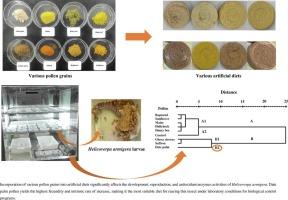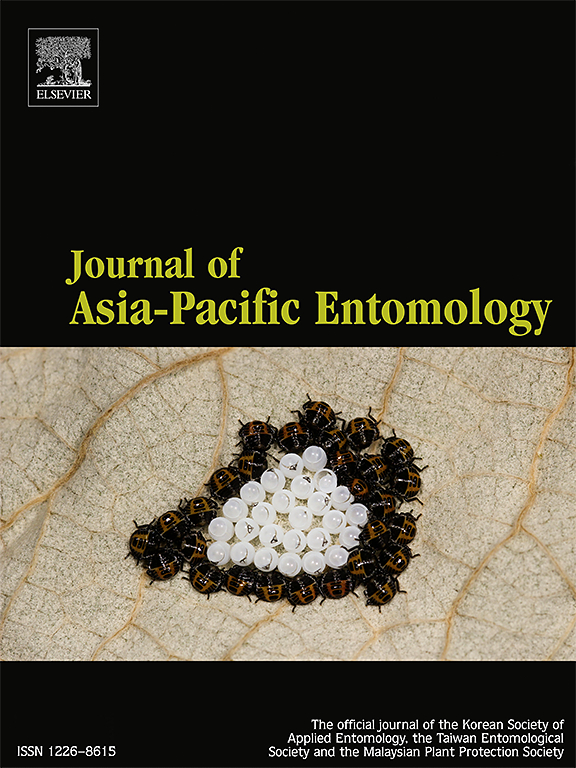The suitability of artificial diets containing diverse pollen grains to Helicoverpa armigera (Hübner): Population growth performance and antioxidant enzymes activities
IF 1.3
3区 农林科学
Q3 ENTOMOLOGY
引用次数: 0
Abstract
In recent years, improving host quality for parasitoids has gained attention due to its importance in providing adequate nutrition for immature stages and ensuring successful adult reproduction. Incorporation of plant materials into artificial diets can significantly influence the performance of host insects. This study evaluated the effects of supplementing a basic artificial diet (control) with various pollen grains (glossy shower, hollyhock, honey bee, maize, date palm, rapeseed, saffron, and sunflower) on population growth performance and antioxidant enzymes activities of Helicoverpa armigera Hübner (Lepidoptera: Noctuidae), a commonly used host for parasitoid rearing. All pollen–contained diets supported complete development of H. armigera, though its performance varied among treatments. The shortest developmental time was recorded in larvae fed on the date palm–pollen–contained artificial diet. The female fecundity was highest on date palm–pollen–contained diet (1140.53 offspring), compared to the control diet (331.41 offspring). The intrinsic rate of increase (r) ranged from 0.109 to 0.162 day−1, being highest on honey bee- and date palm–pollen–contained diets and lowest on glossy shower-pollen-contained diet. Meanwhile, the shortest mean generation time (T) was obtained on date palm–pollen–contained diet. The antioxidant enzymes activities, including superoxide dismutase (SOD), peroxidase (POD), and catalase (CAT) were elevated in larvae fed on maize–, glossy shower–, and saffron–pollen–contained diets, respectively. The cluster analysis confirmed that the date palm–pollen–incorporated artificial diet most effectively enhanced the quality of H. armigera and thus, can be recommended for use in rearing of this species.

不同花粉粒人工饲料对棉铃虫的适宜性:种群生长性能和抗氧化酶活性
近年来,提高寄主质量对于为未成熟阶段提供足够的营养和确保成虫成功繁殖具有重要意义,因此受到了人们的关注。在人工饲料中添加植物材料可显著影响寄主昆虫的生产性能。研究了在基础人工饲粮(对照)中添加不同花粉粒(花洒、山葵、蜜蜂、玉米、枣椰树、油菜籽、藏红花和向日葵)对棉铃虫(Helicoverpa armigera h bner)种群生长性能和抗氧化酶活性的影响。棉铃虫是寄生蜂饲养的常用寄主。所有含有花粉的饮食都支持棉铃虫的完全发育,尽管其表现在不同的处理中有所不同。以含椰枣花粉的人工饲料饲喂的幼虫发育时间最短。椰枣花粉组雌蜂繁殖力最高,为1140.53只,而对照组为331.41只。内在增长率(r)范围为0.109 ~ 0.162天−1,在含有蜜蜂和椰枣花粉的日粮中最高,在含有光面花花粉的日粮中最低。同时,椰枣花粉饲粮的平均世代时间(T)最短。饲粮中玉米、花洒和藏红花花粉分别提高了幼虫的超氧化物歧化酶(SOD)、过氧化物酶(POD)和过氧化氢酶(CAT)活性。聚类分析结果表明,以椰枣花粉为主要成分的人工饲料能有效提高棉铃虫的品质,可推荐用于棉铃虫的饲养。
本文章由计算机程序翻译,如有差异,请以英文原文为准。
求助全文
约1分钟内获得全文
求助全文
来源期刊

Journal of Asia-pacific Entomology
Agricultural and Biological Sciences-Insect Science
CiteScore
2.70
自引率
6.70%
发文量
152
审稿时长
69 days
期刊介绍:
The journal publishes original research papers, review articles and short communications in the basic and applied area concerning insects, mites or other arthropods and nematodes of economic importance in agriculture, forestry, industry, human and animal health, and natural resource and environment management, and is the official journal of the Korean Society of Applied Entomology and the Taiwan Entomological Society.
 求助内容:
求助内容: 应助结果提醒方式:
应助结果提醒方式:


